Radio, Podcasts, and Music Streaming—An Electroencephalography and Physiological Analysis of Listeners’ Attitude, Attention, Memory, and Engagement
Abstract
1. Introduction
Radio, Podcast, and Music Consumption, and Processing
- Q1. Which audio format will elicit the highest level of engagement?
- Q2. Which audio format will elicit the most positive attitude?
- Q3. Which of the three audio formats will be more aligned with memory processing?
- Q4. What kind of format will achieve more attention and recall?
- Q5. Which of the audio formats will result in the highest levels of arousal?
2. Materials and Methods
2.1. Participants
2.2. Audio Stimuli
2.2.1. Radio
2.2.2. Podcasts
2.2.3. Music Streaming
2.3. Lab Experiments
2.4. Variables
2.5. Signal Analysis & Data Analysis
3. Results
3.1. EEG
3.2. Physiology
4. Discussion
5. Limitations & Future Research
6. Conclusions
Author Contributions
Funding
Institutional Review Board Statement
Informed Consent Statement
Data Availability Statement
Acknowledgments
Conflicts of Interest
References
- Colapinto, C.; Manzi, G. Music listening in the twenty-first century: Italian consumer attitudes to Internet radio. Radio J. Int. Stud. Broadcast Audio Media 2016, 14, 213–229. [Google Scholar] [CrossRef] [PubMed]
- Edison Research; Triton Digital. The Infinite Dial; Edison Research: Somerville, NJ, USA, 2021; Available online: https://www.edisonresearch.com/the-infinite-dial-2021-2/ (accessed on 16 June 2022).
- The Insight Partners. Music Streaming Market Forecast to 2027—COVID-19 Impact and Global Analysis by Content Type; Streaming Type; End User; The Insight Partners: Pune, India, 2020; pp. 1–160. [Google Scholar]
- Grand View Research. Podcasting Market Size, Share & Trends Analysis Report by Genre (News & Politics, Society & Culture, Comedy, Sports, Repurposed Content), by Formats (Interviews, Panels, Solo, Conversational), and Segment Forecasts, 2020–2027; Grand View Research: San Francisco, CA, USA, 2020. [Google Scholar]
- Rodero, E. Radio: The medium that best copes in crises. Listening habits, consumption, and perception of radio listeners during the lockdown by the COVID-19. Prof. Inf. 2020, 29, 5. [Google Scholar]
- NPR; Edison Research. Radio: Live on Air and Everywhere; NPR & Edison Research: Somerville, NJ, USA, 2021; Available online: https://www.nationalpublicmedia.com/insights/reports/radio-live-on-air-and-everywhere/ (accessed on 16 June 2022).
- Colburn, C. Digital Audio Proves Resilient during the Pandemic; Forrester: Tokyo, Japan, 2021; Available online: https://www.forrester.com/blogs/digital-audio-proves-resilient-during-the-pandemic/ (accessed on 16 June 2022).
- Edison Research. Super Listeners 2020; Edison Research: Somerville, NJ, USA, 2020; Available online: https://www.edisonresearch.com/super-listeners-2020/ (accessed on 16 June 2022).
- Frith, S. Music and Everyday Life; Routledge: New York, NY, USA, 2003. [Google Scholar]
- Abolhasani, M.; Oakes, S.; Oakes, H. Music in advertising and consumer identity. Mark. Theory 2017, 17, 473–490. [Google Scholar] [CrossRef]
- Garrido, S.; Schubert, E.; Bangert, D. Musical prescriptions for mood improvement: An experimental study. Arts Psychother. 2016, 51, 46–53. [Google Scholar] [CrossRef]
- Hou, J.; Song, B.; Chen, A.C.N.; Sun, C.; Zhou, J.; Zhu, H.; Beauchaine, T.P. Review on Neural Correlates of Emotion Regulation and Music: Implications for Emotion Dysregulation. Front. Psychol. 2017, 8, 1. [Google Scholar] [CrossRef] [PubMed]
- Anisimova, T.; Müllern, T. Popular Music in Audio-Visual Advertising: A Study of the Roles and Functions of Lyrics in TV-Commercials. Adv. Soc. Sci. Res. J. 2014, 1, 8–21. [Google Scholar] [CrossRef][Green Version]
- Gauvin, H.L. Drawing listener attention in popular music: Testing five musical features arising from the theory of attention economy. Music. Sci. 2017, 22, 291–304. [Google Scholar] [CrossRef]
- Raja, M.W.; Anand, S.; Allan, D. How Ad Music Attitude-Based Consumer Segmentation Can Help Advertisers. J. Int. Consum. Mark. 2020, 32, 383–399. [Google Scholar] [CrossRef]
- Guido, G.; Peluso, A.M.; Mileti, A.; Capestro, M.; Cambò, L.; Pisanello, P. Effects of background music endings on consumer memory in advertising. Int. J. Advert. 2016, 35, 504–518. [Google Scholar] [CrossRef]
- Bosshard, S.S.; Bourke, J.D.; Kunaharan, S.; Koller, M.; Walla, P. Established liked versus disliked brands: Brain activity, implicit associations and explicit responses. Cogent Psychol. 2016, 3, 482–492. [Google Scholar] [CrossRef]
- North, A.C.; Hargreaves, D.J.; McKendrick, J. The influence of in-store music on wine selections. J. Appl. Psychol. 1999, 84, 271–276. [Google Scholar] [CrossRef]
- Palazzi, A.; Fritzen, B.; Gauer, G. Music-induced emotion effects on decision-making. Psychol. Music 2018, 47, 030573561877922. [Google Scholar] [CrossRef]
- Lacey, K. Smart radio and audio apps: The politics and paradoxes of listening to (anti-) social media. Aust. J. Rev. 2014, 36, 77–90. [Google Scholar]
- Walla, P.; Brenner, G.; Koller, M. Objective Measures of Emotion Related to Brand Attitude: A New Way to Quantify Emotion-Related Aspects Relevant to Marketing. PLoS ONE 2011, 6, e26782. [Google Scholar] [CrossRef] [PubMed]
- Bosshard, S.; Walla, P. Sonic Influence on Initially Neutral Brands: Using EEG to Unveil the Secrets of Audio Evaluative Conditioning. Brain Sci. 2023, 13, 1393. [Google Scholar] [CrossRef] [PubMed]
- Zaltman, G. How Customers Think: Essential Insights into the Mind of the Market; Harvard Business School Press: Boston, MA, USA, 2003. [Google Scholar]
- Kim, J.; Ahn, S.J.; Kwon, E.S.; Reid, L.N. TV advertising engagement as a state of immersion and presence. J. Bus. Res. 2017, 76, 67–76. [Google Scholar] [CrossRef]
- Kakkos, I.; Dimitrakopoulos, G.N.; Gao, L.; Zhang, Y.; Qi, P.; Matsopoulos, G.K.; Thakor, N.; Bezerianos, A.; Sun, Y. Mental Workload Drives Different Reorganizations of Functional Cortical Connectivity Between 2D and 3D Simulated Flight Experiments. IEEE Trans. Neural Syst. Rehabil. Eng. 2019, 27, 1704–1713. [Google Scholar] [CrossRef] [PubMed]
- Walter, C.; Rosenstiel, W.; Bogdan, M.; Gerjets, P.; Spüler, M. Online EEG-Based Workload Adaptation of an Arithmetic Learning Environment. Front. Hum. Neurosci. 2017, 11, 286. [Google Scholar] [CrossRef]
- Zarjam, P.; Epps, J.; Chen, F.; Lovell, N.H. Estimating cognitive workload using wavelet entropy-based features during an arithmetic task. Comput. Biol. Med. 2013, 43, 2186–2195. [Google Scholar] [CrossRef]
- Gupta, R.; ur Rehman Laghari, K.; Falk, T.H. Relevance vector classifier decision fusion and EEG graph-theoretic features for automatic affective state characterization. Neurocomputing 2016, 174, 875–884. [Google Scholar] [CrossRef]
- Ramsøy, T.Z.; Skov, M.; Christensen, M.K.; Stahlhut, C. Frontal Brain Asymmetry and Willingness to Pay. Front. Neurosci. 2018, 12, 138. [Google Scholar] [CrossRef] [PubMed]
- Astolfi, L.; Fallani, F.D.V.; Cincotti, F.; Mattia, D.; Bianchi, L.; Marciani, M.G.; Salinari, S.; Colosimo, A.; Tocci, A.; Soranzo, R.; et al. Neural basis for brain responses to TV commercials: A high-resolution EEG study. IEEE Trans. Neural Syst. Rehabil. Eng. Publ. IEEE Eng. Med. Biol. Soc. 2008, 16, 522–531. [Google Scholar] [CrossRef]
- Boksem, M.A.S.; Smidts, A. Brain responses to movie trailers predict individual preferences for movies and their population-wide commercial success. J. Mark. Res. 2015, 52, 482–492. [Google Scholar] [CrossRef]
- Razak, N.; Themba, O.S.; Sjahruddin, H. Brand awareness as predictors of repurchase intention: Brand attitude as a moderator. Adv. Soc. Sci. Res. J. 2019, 6, 541–554. [Google Scholar]
- Davidson, R.J.; Schwartz, G.E.; Saron, C.; Bennet, J.; Goleman, D.J. Frontal versus parietal EEG asymmetry during positive and negative affect. Psychophysiology 1979, 16, 202–203. [Google Scholar]
- Ravaja, N.; Somervuori, O.; Salminen, M. Predicting purchase decision: The role of hemispheric asymmetry over the frontal cortex. J. Neurosci. Psychol. Econ. 2013, 6, 1–13. [Google Scholar] [CrossRef]
- Ohme, R.; Reykowska, D.; Wiener, D.; Choromanska, A. Analysis of neurophysiological reactions to advertising stimuli by means of EEG and galvanic skin response measures. J. Neurosci. Psychol. Econ. 2009, 2, 21–31. [Google Scholar] [CrossRef]
- Alvino, L.; Luigi, P.; Abhishta, A.; Henry, R. Picking Your Brains: Where and How Neuroscience Tools Can Enhance Marketing Research. Sec. Decis. Neurosci. 2020, 14, 577666. [Google Scholar] [CrossRef]
- Cartocci, G.; Cherubino, P.; Rossi, D.; Modica, E.; Maglione, A.G.; di Flumeri, G.; Babiloni, F. Gender and Age Related Effects While Watching TV Advertisements: An EEG Study. Comput. Intell. Neurosci. 2016, 2016, 3795325. [Google Scholar] [CrossRef] [PubMed]
- Jones, N.A.; Fox, N.A. Electroencephalogram asymmetry during emotionally evocative films and its relation to positive and negative affectivity. Brain Cogn. 1992, 20, 280–299. [Google Scholar] [CrossRef]
- Ohme, R.; Reykowska, D.; Wiener, D.; Choromanska, A. Application of frontal EEG asymmetry to advertising research. J. Econ. Psychol. 2010, 31, 785–793. [Google Scholar] [CrossRef]
- Ohme, R.; Matukin, M.; Pacula-Lesniak, B. Biometric Measures for Interactive Advertising Research. J. Interact. Advert. 2011, 11, 60–72. [Google Scholar] [CrossRef]
- Wilson, A.L.; Sharp, B.; Nguyen, C.; Bogomolova, S. Expanding Marketing Empirical Generalisations to Health Behaviours: Physical Activity is Not so Different from Buying Behaviour, after-All. Australas. Mark. J. 2017, 25, 317–325. [Google Scholar] [CrossRef]
- Norris, C.E.; Colman, A.M. Context effects on memory for television advertisments. Soc. Behav. Personal. Int. J. 1993, 21, 279–296. [Google Scholar] [CrossRef][Green Version]
- Tulving, E.; Kapur, S.; Craik, F.I.; Moscovitch, M.; Houle, S. Hemispheric encoding/retrieval asymmetry in episodic memory: Positron emission tomography findings. Proc. Natl. Acad. Sci. USA 1994, 91, 2016–2020. [Google Scholar] [CrossRef] [PubMed]
- Eschmann, K.C.J.; Bader, R.; Mecklinger, A. Improving episodic memory: Frontal-midline theta neurofeedback training increases source memory performance. NeuroImage 2020, 222, 117219. [Google Scholar] [CrossRef]
- Gruber, T.; Tsivilis, D.; Giabbiconi, C.-M.; Müller, M.M. Induced electroencephalogram oscillations during source memory: Familiarity is reflected in the gamma band, recollection in the theta band. J. Cogn. Neurosci. 2008, 20, 1043–1053. [Google Scholar] [CrossRef] [PubMed]
- Guderian, S.; Düzel, E. Induced theta oscillations mediate large-scale synchrony with mediotemporal areas during recollection in humans. Hippocampus 2005, 15, 901–912. [Google Scholar] [CrossRef]
- Klimesch, W.; Doppelmayr, M.; Stadler, W.; Pöllhuber, D.; Sauseng, P.; Röhm, D. Episodic retrieval is reflected by a process specific increase in human electroencephalographic theta activity. Neurosci. Lett. 2001, 302, 49–52. [Google Scholar] [CrossRef]
- Nyhus, E.; Curran, T. Functional role of gamma and theta oscillations in episodic memory. Neurosci. Biobehav. Rev. 2010, 34, 1023–1035. [Google Scholar] [CrossRef]
- Sauseng, P.; Griesmayr, B.; Freunberger, R.; Klimesch, W. Control mechanisms in working memory: A possible function of EEG theta oscillations. Neurosci. Biobehav. Rev. 2010, 34, 1015–1022. [Google Scholar] [CrossRef] [PubMed]
- Vecchiato, G.; Astolfi, L.; Tabarrini, A.; Salinari, S.; Mattia, D.; Cincotti, F.; Bianchi, L.; Sorrentino, D.; Aloise, F.; Soranzo, R.; et al. EEG Analysis of the Brain Activity during the Observation of Commercial, Political, or Public Service Announcements. Comput. Intell. Neurosci. 2010, 2010, 985867. [Google Scholar] [CrossRef]
- Silberstein, R.B.; Nield, G.E. Brain activity correlates of consumer brand choice shift associated with television advertising. Int. J. Advert. 2008, 27, 359–380. [Google Scholar] [CrossRef]
- Shestyuk, A.Y.; Kasinathan, K.; Karapoondinott, V.; Knight, R.T.; Gurumoorthy, R. Individual EEG measures of attention, memory, and motivation predict population level TV viewership and Twitter engagement. PLoS ONE 2019, 14, e0214507. [Google Scholar] [CrossRef]
- Kong, W.; Zhao, X.; Hu, S.; Vecchiato, G.; Babiloni, F. Electronic evaluation for video commercials by impression index. Cogn. Neurodyn. 2013, 7, 531–535. [Google Scholar] [CrossRef] [PubMed]
- Foxe, J.J.; Simpson, G.V.; Ahlfors, S.P. Parieto-occipital approximately 10 Hz activity reflects anticipatory state of visual attention mechanisms. Neuroreport 1998, 9, 3929–3933. [Google Scholar] [CrossRef] [PubMed]
- Hossain, G.; Myers, M.H.; Kozma, R. Spatial Directionality Found in Frontal-Parietal Attentional Networks. Neurosci. J. 2018, 2018, 7879895. [Google Scholar] [CrossRef] [PubMed]
- Magosso, E.; De Crescenzio, F.; Ricci, G.; Piastra, S.; Ursino, M. EEG Alpha Power Is Modulated by Attentional Changes during Cognitive Tasks and Virtual Reality Immersion. Comput. Intell. Neurosci. 2019, 2019, 7051079. [Google Scholar] [CrossRef]
- Wang, C.; Rajagovindan, R.; Han, S.-M.; Ding, M. Top-Down Control of Visual Alpha Oscillations: Sources of Control Signals and Their Mechanisms of Action. Front. Hum. Neurosci. 2016, 10, 15. [Google Scholar] [CrossRef]
- Jensen, O.; Gelfand, J.; Kounios, J.; Lisman, J.E. Oscillations in the alpha band (9–12 Hz) increase with memory load during retention in a short-term memory task. Cereb. Cortex 2002, 12, 877–882. [Google Scholar] [CrossRef]
- Klimesch, W.; Doppelmayr, M.; Schwaiger, J.; Auinger, P.; Winkler, T. ‘Paradoxical’ alpha synchronization in a memory task. Cogn. Brain Res. 1999, 7, 493–501. [Google Scholar] [CrossRef] [PubMed]
- Vanni, S.; Revonsuo, A.; Hari, R. Modulation of the parieto-occipital alpha rhythm during object detection. J. Neurosci. Off. J. Soc. Neurosci. 1997, 17, 7141–7147. [Google Scholar] [CrossRef]
- Klimesch, W.; Sauseng, P.; Hanslmayr, S. EEG alpha oscillations: The inhibition–timing hypothesis. Brain Res. Rev. 2007, 53, 63–88. [Google Scholar] [CrossRef]
- Cooper, N.R.; Croft, R.J.; Dominey, S.J.J.; Burgess, A.P.; Gruzelier, J.H. Paradox lost? Exploring the role of alpha oscillations during externally vs. internally directed attention and the implications for idling and inhibition hypotheses. Int. J. Psychophysiol. Off. J. Int. Organ. Psychophysiol. 2003, 47, 65–74. [Google Scholar] [CrossRef]
- von Stein, A.; Sarnthein, J. Different frequencies for different scales of cortical integration: From local gamma to long range alpha/theta synchronization. Int. J. Psychophysiol. 2000, 38, 301–313. [Google Scholar] [CrossRef]
- Cartocci, G.; Maglione, A.G.; Rossi, D.; Modica, E.; Borghini, G.; Malerba, P.; Piccioni, L.O.; Babiloni, F. Alpha and Theta EEG Variations as Indices of Listening Effort to Be Implemented in Neurofeedback Among Cochlear Implant Users. In Symbiotic Interaction; Ham, J., Spagnolli, A., Blankertz, B., Gamberini, L., Jacucci, G., Eds.; Springer International Publishing: Cham, Switzerland, 2018; pp. 30–41. [Google Scholar] [CrossRef]
- Keller, A.S.; Payne, L.; Sekuler, R. Characterizing the roles of alpha and theta oscillations in multisensory attention. Neuropsychologia 2017, 99, 48–63. [Google Scholar] [CrossRef] [PubMed]
- Marsella, P.; Scorpecci, A.; Cartocci, G.; Giannantonio, S.; Maglione, A.G.; Venuti, I.; Brizi, A.; Babiloni, F. EEG activity as an objective measure of cognitive load during effortful listening: A study on pediatric subjects with bilateral, asymmetric sensorineural hearing loss. Int. J. Pediatr. Otorhinolaryngol. 2017, 99, 1–7. [Google Scholar] [CrossRef]
- Misselhorn, J.; Friese, U.; Engel, A.K. Frontal and parietal alpha oscillations reflect attentional modulation of cross-modal matching. Sci. Rep. 2019, 9, 5030. [Google Scholar] [CrossRef]
- Teplan, M.; Krakovská, A.; Štolc, S. EEG responses to long-term audio–visual stimulation. Int. J. Psychophysiol. 2006, 59, 81–90. [Google Scholar] [CrossRef]
- Wisniewski, M.G.; Thompson, E.R.; Iyer, N. Theta- and alpha-power enhancements in the electroencephalogram as an auditory delayed match-to-sample task becomes impossibly difficult. Psychophysiology 2017, 54, 1916–1928. [Google Scholar] [CrossRef]
- Singh, S.N.; Churchill, G.A. Arousal and Advertising Effectiveness. J. Advert. 1987, 16, 4–40. [Google Scholar] [CrossRef]
- Ravaja. Contributions of psychophysiology to media research: Review and recommendations. Media Psychol. 2004, 6, 193–235. [Google Scholar] [CrossRef]
- Veeranki, Y.R.; Kumar, H.; Ganapathy, N.; Natarajan, B.; Swaminathan, R. A Systematic Review of Sensing and Differentiating Dichotomous Emotional States Using Audio-Visual Stimuli. IEEE Access 2021, 9, 124434–124451. [Google Scholar] [CrossRef]
- Australian Radio Network. Audio Study; Australian Radio Network: Sydney, Australia, 2019. [Google Scholar]
- Schubert, E. The fundamental function of music. Music. Sci. 2009, 13, 63–81. [Google Scholar] [CrossRef]
- Huron, D. Is Music an Evolutionary Adaptation? Ann. N. Y. Acad. Sci. 2001, 930, 43–61. [Google Scholar] [CrossRef] [PubMed]
- Bicknell, J. Explaining Strong Emotional Responses to Music. J. Conscious. Stud. 2005, 14, 5–23. [Google Scholar]
- Mithen, S.J. The Singing Neanderthals: The Origins of Music, Language, Mind, and Body; Harvard University Press: Cambridge, MA, USA, 2006. [Google Scholar]
- Jenkins, P. Formal and Informal Music Educational Practices. Philos. Music Educ. Rev. 2011, 19, 179–197. [Google Scholar] [CrossRef]
- Schellenberg, E.G. Music Lessons Enhance IQ. Psychol. Sci. 2004, 15, 511–514. [Google Scholar] [CrossRef]
- Edison Research. Podcast Stats & Facts; Edison Research: Somerville, NJ, USA, 2019; Available online: https://www.podcastinsights.com/podcast-statistics/ (accessed on 16 June 2022).
- Edison Research. The Podcast Consumer; Edison Research: Somerville, NJ, USA, 2019; Available online: https://www.edisonresearch.com/the-podcast-consumer-2019/ (accessed on 16 June 2022).
- McClung, S.; Johnson, K. Examining the Motives of Podcast Users. J. Radio Audio Media 2010, 17, 82–95. [Google Scholar] [CrossRef]
- Fietze, S. Podcast in higher education: Students usage behaviour. Proc. Ascilite Auckl. 2009, 2009, 314–318. [Google Scholar]
- Ollari, K. How Podcasts Became the Radio of the Future: Understanding Factors That Influence Podcast Consumption among Millennials. Master’s Thesis, Aalto University, Espoo, Finland, 2020. [Google Scholar]
- Li, A.; Wang, A.; Nazari, Z.; Chandar, P.; Carterette, B. Do podcasts and music compete with one another? Understanding users’ audio streaming habits. In Proceedings of the Web Conference 2020, Taipei, Taiwan, 20–24 April 2020; Association for Computing Machinery: New York, NY, USA, 2020; pp. 1920–1931. [Google Scholar] [CrossRef]
- Geethanjali, B.; Adalarasu, K.; Rajsekaran, R. Impact of Music on Brain Function during Mental Task using Electroencephalography. Int. J. Biomed. Biol. Eng. 2012, 6, 256–260. [Google Scholar]
- Jones, L.; Karageorghis, C.I.; Ekkekakis, P. Can high-intensity exercise be more pleasant? Attentional dissociation using music and video. J. Sport Exerc. Psychol. 2014, 36, 528–541. [Google Scholar] [CrossRef]
- Stork, M.J.; Karageorghis, C.I.; Martin Ginis, K.A. Let’s Go: Psychological, psychophysical, and physiological effects of music during sprint interval exercise. Psychol. Sport Exerc. 2019, 45, 101547. [Google Scholar] [CrossRef]
- Stork, M.J.; Kwan, M.Y.W.; Gibala, M.J.; Martin Ginis, K.A. Music Enhances Performance and Perceived Enjoyment of Sprint Interval Exercise. Med. Sci. Sports Exerc. 2015, 47, 1052–1060. [Google Scholar] [CrossRef]
- Bhatti, A.M.; Majid, M.; Anwar, S.M.; Khan, B. Human emotion recognition and analysis in response to audio music using brain signals. Comput. Hum. Behav. 2016, 65, 267–275. [Google Scholar] [CrossRef]
- Plourde-Kelly, A.D.; Saroka, K.S.; Dotta, B.T. The impact of emotionally valenced music on emotional state and EEG profile: Convergence of self-report and quantitative data. Neurosci. Lett. 2021, 758, 136009. [Google Scholar] [CrossRef]
- Carpentier, F.R.D. Innovating Radio News: Effects of Background Music Complexity on Processing and Enjoyment. J. Radio Audio Media 2010, 17, 63–81. [Google Scholar] [CrossRef]
- Albarran, A.B.; Anderson, T.; Bejar, L.G.; Bussart, A.L.; Daggett, E.; Gibson, S.; Gorman, M.; Greer, D.; Guo, M.; Horst, J.L.; et al. “What Happened to our Audience?” Radio and New Technology Uses and Gratifications Among Young Adult Users. J. Radio Stud. 2007, 14, 92–101. [Google Scholar] [CrossRef]
- Chan-Olmsted, S.; Wang, R.; Hwang, K.-H. Substitutability and complementarity of broadcast radio and music streaming services: The millennial perspective. Mob. Media Commun. 2019, 8, 209–228. [Google Scholar] [CrossRef]
- Martín-Luengo, B.; Luna, K.; Migueles, M. Effects of Interest, Thematic Congruence, and Typicality on Memory for Television, Radio, and Press Advertisements of New Products. Appl. Cogn. Psychol. 2015, 29, 560–572. [Google Scholar] [CrossRef]
- Dua, M.J.; Charlton, S.G. Audio on the go: The effect of audio cues on memory in driving. Transp. Res. Interdiscip. Perspect. 2019, 1, 100004. [Google Scholar] [CrossRef]
- Allan, D. Effects of Popular Music in Advertising on Attention and Memory. J. Advert. Res. 2006, 46, 434–444. [Google Scholar] [CrossRef]
- Nyre, L. Urban Headphone Listening and the Situational Fit of Music, Radio and Podcasting. J. Radio Audio Media 2015, 22, 279–298. [Google Scholar] [CrossRef]
- Cabañero, L.; Hervás, R.; González, I.; Fontecha, J.; Mondéjar, T.; Bravo, J. Characterisation of mobile-device tasks by their associated cognitive load through EEG data processing. Future Gener. Comput. Syst. 2020, 113, 380–390. [Google Scholar] [CrossRef]
- Super, S.; Aminuddin, M.M.; Dom, H.M. Comparison of meaningful sound vs no sound for avoiding attention drifting phenomenon while driving. J. Telecommun. Electron. Comput. Eng. 2016, 8, 19–23. [Google Scholar]
- Aminuddin, M.M.M.; Nasir, H.M. The Feasibility of Music and Talk Radio Program as a Focus Stimulant for Driver. Int. J. Hum. Technol. Interact. 2018, 2, 45–50. [Google Scholar]
- Groeppel-Klein, A. Arousal and consumer in-store behavior. Brain Res. Bull. 2005, 67, 428–437. [Google Scholar] [CrossRef]
- Donovan, R.; Rossiter, J. Store Atmosphere: An Environmental Psychology Approach. J. Retail. 1982, 58, 34–57. [Google Scholar]
- Groeppel-Klein, A.; Baun, D. The Role of Customers’ Arousal For Retail Store—Results From an Experimental Pilot Study Using Electrodermal Activity As Indicator. ACR N. Am. Adv Consum. Res. 2001, 28, 412–419. [Google Scholar]
- Dillman Carpentier, F.R.; Potter, R.F. Effects of Music on Physiological Arousal: Explorations into Tempo and Genre. Media Psychol. 2007, 10, 339–363. [Google Scholar] [CrossRef]
- Gregersen, A.; Langkjær, B.; Heiselberg, L.; Wieland, J.L. Following the viewers: Investigating television drama engagement through skin conductance measurements. Poetics 2017, 64, 1–13. [Google Scholar] [CrossRef]
- Rodero, E.; Potter, R.F.; Prieto, P. Pitch Range Variations Improve Cognitive Processing of Audio Messages: Pitch Variations Improve Cognitive Processing. Hum. Commun. Res. 2017, 43, 397–413. [Google Scholar] [CrossRef]
- Ünal, A.B.; de Waard, D.; Epstude, K.; Steg, L. Driving with music: Effects on arousal and performance. Transp. Res. Part F Traffic Psychol. Behav. 2013, 21, 52–65. [Google Scholar] [CrossRef]
- Peacock, J.; Purvis, S.; Hazlett, R.L. Which Broadcast Medium Better Drives Engagement?: Measuring the Powers of Radio and Television with Electromyography and Skin-Conductance Measurements. J. Advert. Res. 2011, 51, 578–585. [Google Scholar] [CrossRef]
- Bigliassi, M.; Karageorghis, C.I.; Hoy, G.K.; Layne, G.S. The Way You Make Me Feel: Psychological and cerebral responses to music during real-life physical activity. Psychol. Sport Exerc. 2019, 41, 211–217. [Google Scholar] [CrossRef]
- Bigliassi, M.; Karageorghis, C.I.; Wright, M.J.; Orgs, G.; Nowicky, A.V. Effects of auditory stimuli on electrical activity in the brain during cycle ergometry. Physiol. Behav. 2017, 177, 135–147. [Google Scholar] [CrossRef] [PubMed]
- Bartlett, D. Physiological Reactions to Music and Acoustic Stimuli; IMR Press: San Antonio, TX, USA, 1996. [Google Scholar]
- Hodges, D.A. Psychophysiological measures. In Handbook of Music and Emotion: Theory, Research, Applications; Juslin, P.N., Sloboda, J.A., Eds.; Oxford University Press: New York, NY, USA, 2010; pp. 279–311. [Google Scholar]
- Panksepp, J.; Bernatzky, G. Emotional sounds and the brain: The neuro-affective foundations of musical appreciation. Behav. Process. 2002, 60, 133–155. [Google Scholar] [CrossRef] [PubMed]
- Rickard, N.S. Intense emotional responses to music: A test of the physiological arousal hypothesis. Psychol. Music 2004, 32, 371–388. [Google Scholar] [CrossRef]
- Trappe, H.-J. The effects of music on the cardiovascular system and cardiovascular health. Heart 2010, 96, 1868–1871. [Google Scholar] [CrossRef]
- Armon, R.; Fisher, A.; Goldfarb, B.; Milton, C. Effects of Music Tempos on Blood Pressure, Heart Rate, and Skin Conductance after Physical Exertion; University of Wisconsin: Madison, WI, USA, 2011. [Google Scholar]
- Edworthy, J.; Waring, H. The effects of music tempo and loudness level on treadmill exercise. Ergonomics 2006, 49, 1597–1610. [Google Scholar] [CrossRef]
- Swartz, B.E. The advantages of digital over analog recording techniques. Electroencephalogr. Clin. Neurophysiol. 1998, 106, 113–117. [Google Scholar] [CrossRef]
- Bosshard, S.; Koller, M.; Walla, P. Can Evaluative Conditioning Change Well-Established Attitudes Towards Popular Brands? Your Brain Says Yes Even Though Your Mouth Says No. Brain Sci. 2019, 9, 106. [Google Scholar] [CrossRef]
- Rothschild, M.L.; Thorson, E.; Reeves, B.; Hirsch, J.E.; Goldstein, R. EEG activity and the processing of television commercials. Commun. Res. 1986, 13, 182–220. [Google Scholar] [CrossRef]
- Rothschild, M.L.; Hyun, Y.J. Predicting Memory for Components of TV Commercials from EEG. J. Consum. Res. 1990, 16, 472–478. [Google Scholar] [CrossRef]
- Gordon, R.; Ciorciari, J.; van Laer, T. Using EEG to Examine the Role of Attention, Working Memory, Emotion, and Imagination in Narrative Transportation. Eur. J. Mark. 2018, 52, 92–117. [Google Scholar] [CrossRef]
- Vecchiato, G.; Astolfi, L.; Fallani, F.D.V.; Cincotti, F.; Mattia, D.; Salinari, S.; Soranzo, R.; Babiloni, F. Changes in brain activity during the observation of TV commercials by using EEG, GSR and HR measurements. Brain Topogr. 2009, 23, 165–179. [Google Scholar] [CrossRef]
- Coan, J.A.; Allen, J.J.B. Frontal EEG asymmetry as a moderator and mediator of emotion. Biol. Psychol. 2004, 67, 7–50. [Google Scholar] [CrossRef]
- Wan, W.; Cui, X.; Gao, Z.; Gu, Z. Frontal EEG-Based Multi-Level Attention States Recognition Using Dynamical Complexity and Extreme Gradient Boosting. Front. Hum. Neurosci. 2021, 15, 673955. [Google Scholar] [CrossRef]
- Habib, R.; Nyberg, L.; Tulving, E. Hemispheric asymmetries of memory: The HERA model revisited. Trends Cogn. Sci. 2003, 7, 241–245. [Google Scholar] [CrossRef]
- Silberstein, R.B.; Harris, P.G.; Nield, G.A.; Pipingas, A. Frontal steady-state potential changes predict long-term recognition memory performance. Int. J. Psychophysiol. 2000, 39, 79–85. [Google Scholar] [CrossRef]
- Peper, E.; Harvey, R.; Lin, I.-M.; Tylova, H.; Moss, D. Is There More to Blood Volume Pulse Than Heart Rate Variability, Respiratory Sinus Arrhythmia, and Cardiorespiratory Synchrony? Biofeedback 2007, 35, 54–61. [Google Scholar]
- Hayes, A.F. SPSS procedures for approximate randomization tests. Behav. Res. Methods Instrum. Comput. 1998, 30, 536–543. [Google Scholar] [CrossRef][Green Version]
- Qiu, L.; Chen, X.; Lee, T.J. How Can the Celebrity Endorsement Effect Help Consumer Engagement? A Case of Promoting Tourism Products through Live Streaming. Sustainability 2021, 13, 8655. [Google Scholar] [CrossRef]
- Tengku Mohd Azzman Shariffadeen, T.S.A.; Manaf, A.M.A. Celebrity-Fan Engagement on Instagram and Its Influence on The Perception of Hijab Culture Among Muslim Women in Malaysia. J. Komun. Malays. J. Commun. 2019, 35, 286–302. [Google Scholar] [CrossRef]
- Phua, J.; Lin, J.-S.; Lim, D.J. Understanding consumer engagement with celebrity-endorsed E-Cigarette advertising on instagram. Comput. Hum. Behav. 2018, 84, 93–102. [Google Scholar] [CrossRef]
- Jovanovic, P.; Vlastelica, T.; Cicvaric Kostic, S. Impact of Advertising Appeals on Purchase Intention. Manag.—J. Theory Pract. Manag. 2016, 21, 35–45. [Google Scholar]
- Hou, J.; Zhao, X.; Zheng, J. The impact of consistency between the emotional feature of advertising music and brand personality on brand experience. J. Manag. Anal. 2019, 6, 250–268. [Google Scholar] [CrossRef]
- Cuesta, U.; Martínez-Martínez, L.; Niño, J.I. A Case Study in Neuromarketing: Analysis of the Influence of Music on Advertising Effectivenes through Eye-Tracking, Facial Emotion and GSR. Eur. J. Soc. Sci. Educ. Res. 2018, 5, 84. [Google Scholar] [CrossRef]
- Rejón-Guardia, F.; Martínez-López, F.J. Online Advertising Intrusiveness and Consumers’ Avoidance Behaviors. In Handbook of Strategic E-Business Management; Martínez-López, F.J., Ed.; Springer: Berlin/Heidelberg, Germany, 2014; pp. 565–586. [Google Scholar] [CrossRef]
- Playground xyz. Attention Time: Redefining How Marketers Measure and Optimize Ads in Real Time; Playground xyz: Sydney, Australia, 2020. [Google Scholar]
- Nelson-Field, K. Attention Elasticity: The Attention Economy’s Chicken and Egg Question. 2022. Available online: www.amplifiedintelligence.com.au/article/attention-elasticity-explained/ (accessed on 15 November 2023).
- Schön, D.; Antonelli, S.; Rothkegel, H.; Münte, T.F. Processing of sung and spoken words in musicians and non-musicians. NeuroImage 2012, 61, 843–849. [Google Scholar]
- Merrill, J.L.; Sammler, R.; Koelsch, S. Neuroanatomical correlates of the abstraction of syntactic structure from speech and melody. J. Neurosci. 2013, 33, 5018–5025. [Google Scholar]
- Merrill, J.L.; Liu, X.; Soto-Faraco, S. Musical prosody modulates neural response to syntactic category. J. Neurosci. 2011, 31, 8111–8118. [Google Scholar]
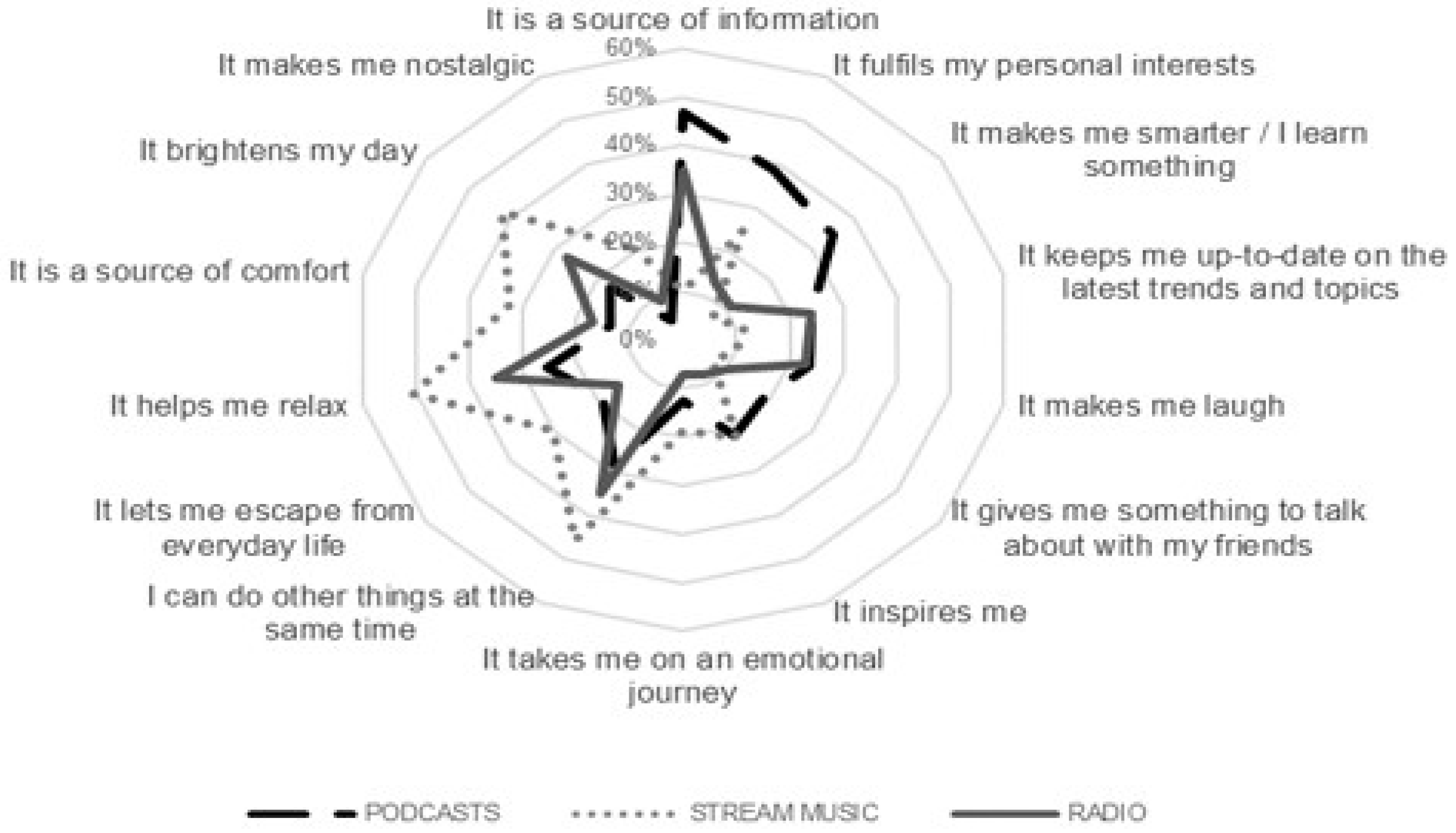
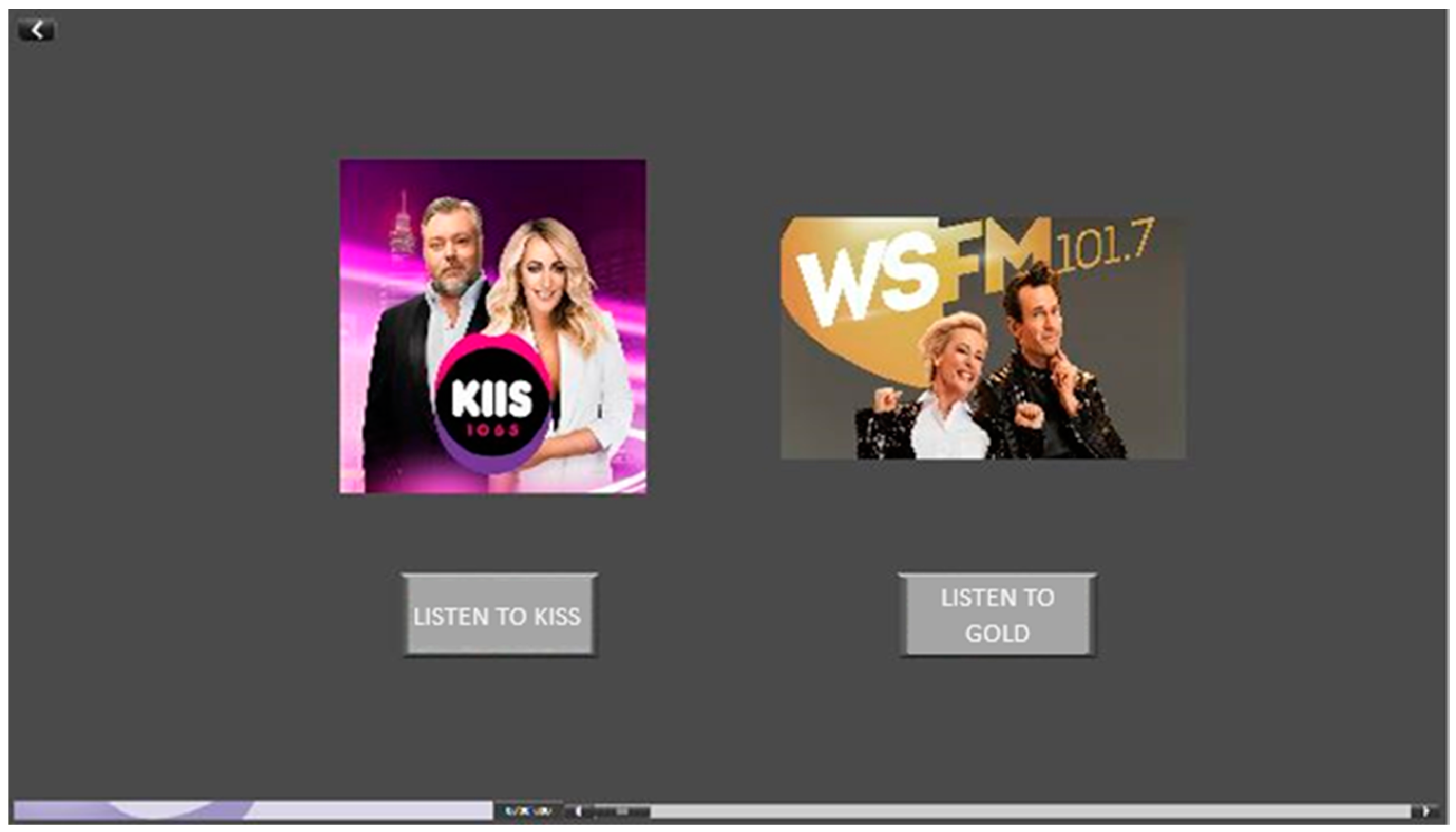
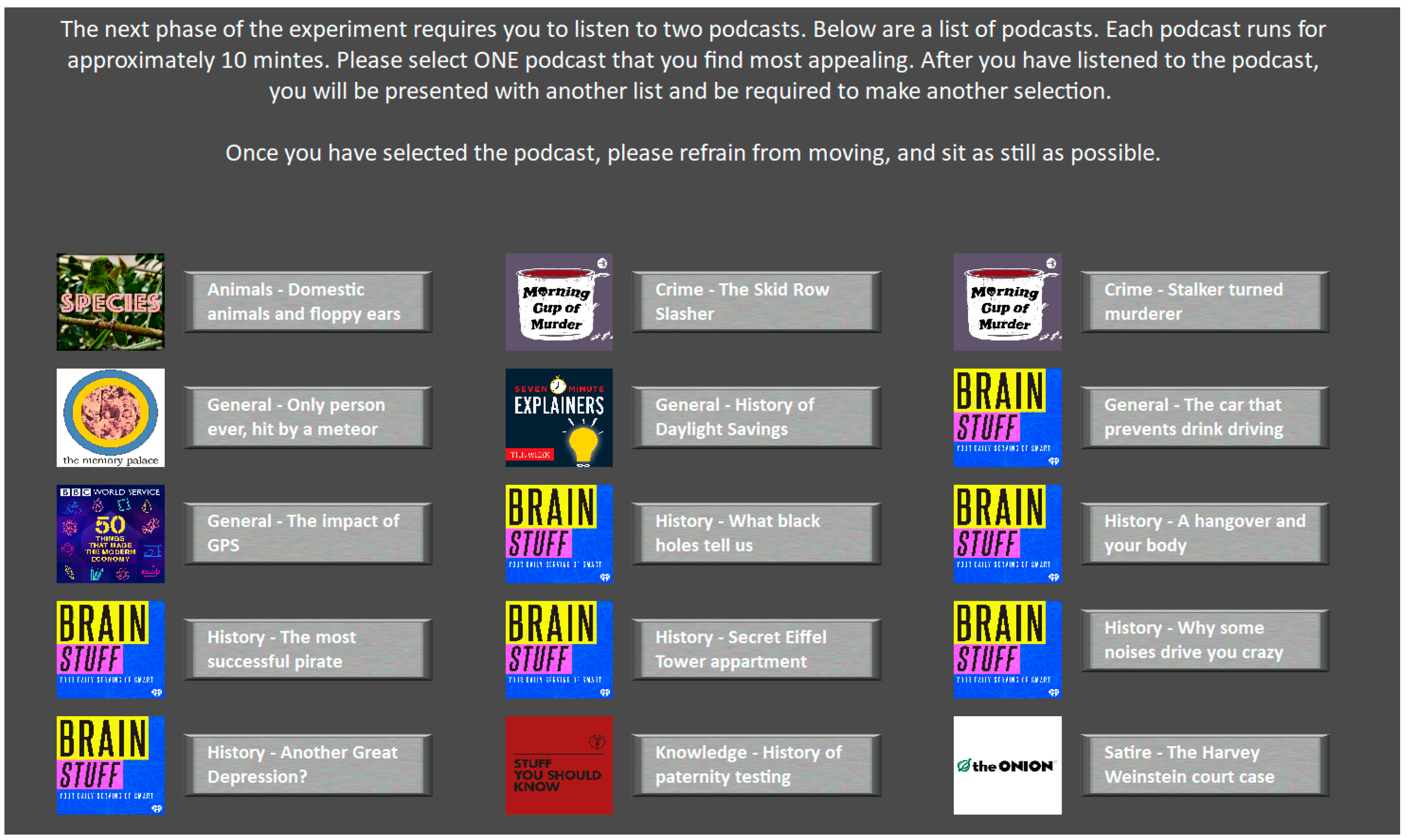
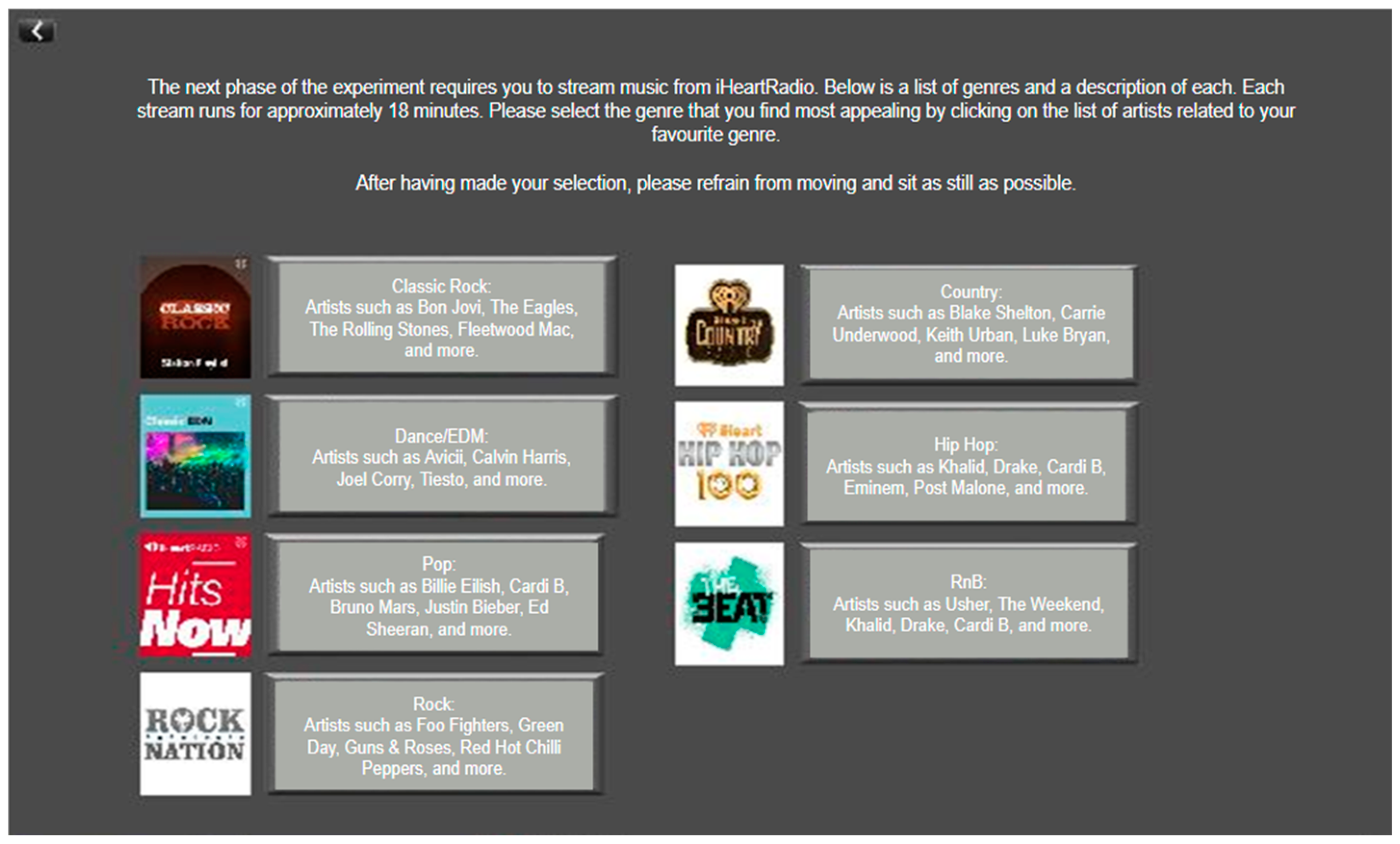
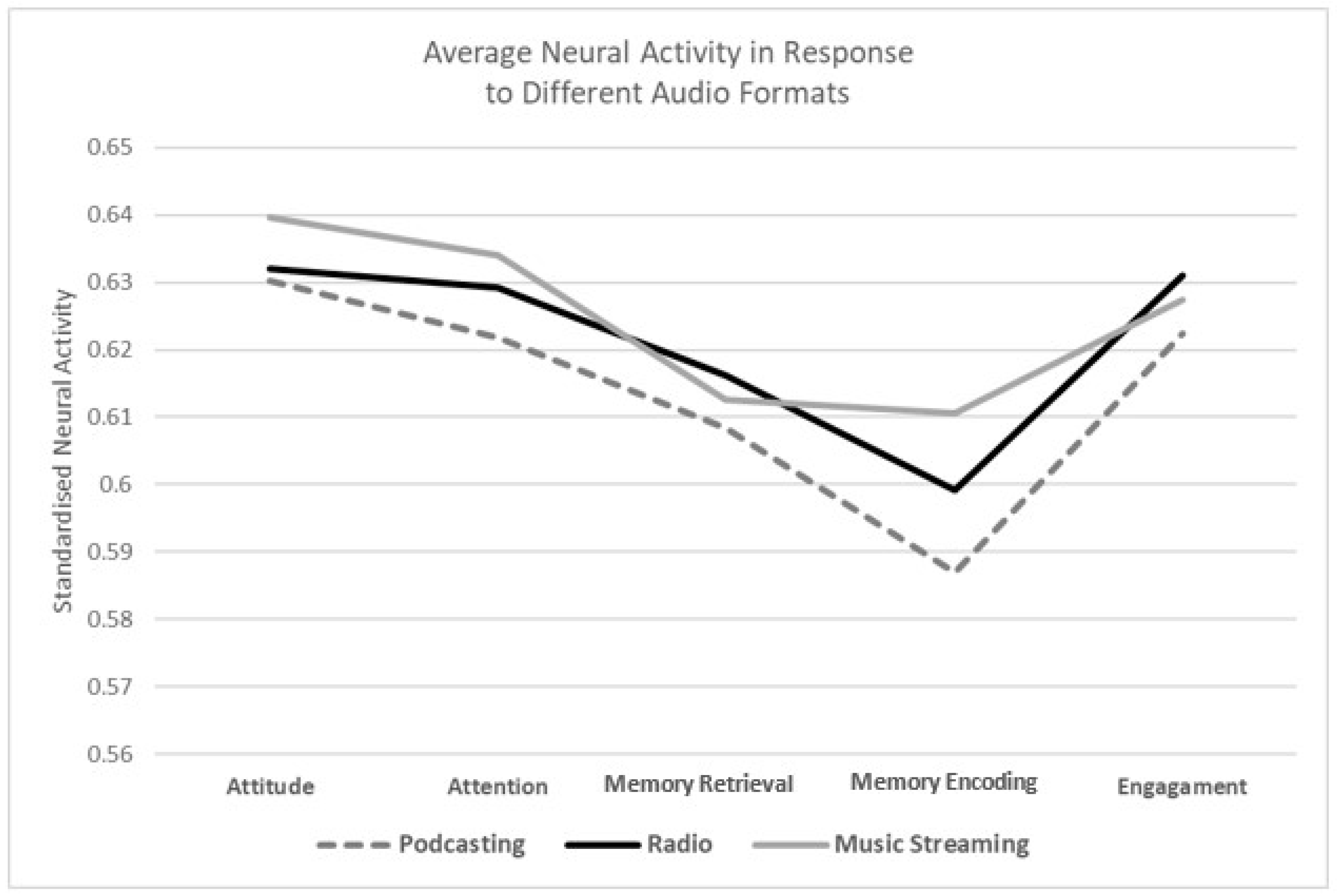
| Group One | Radio | > | Podcasts |
| Group Two | Podcasts | > | Music Streaming |
| Group Three | Music Streaming | > | Radio |
| Group | Task Breakdown | |||||
|---|---|---|---|---|---|---|
| Radio | Radio Listening | Ad Block | Radio Listening | Ad Block | ||
| Podcasts | Ad Block | Podcast Listening | Ad Block | Podcast Listening | Ad Block | |
| Music Streaming | Music | Ad Block | Music | Ad Block | Music | Ad Block |
Disclaimer/Publisher’s Note: The statements, opinions and data contained in all publications are solely those of the individual author(s) and contributor(s) and not of MDPI and/or the editor(s). MDPI and/or the editor(s) disclaim responsibility for any injury to people or property resulting from any ideas, methods, instructions or products referred to in the content. |
© 2024 by the authors. Licensee MDPI, Basel, Switzerland. This article is an open access article distributed under the terms and conditions of the Creative Commons Attribution (CC BY) license (https://creativecommons.org/licenses/by/4.0/).
Share and Cite
Bosshard, S.; Rodero, E.; Rodríguez-de-Dios, I.; Brickner, J. Radio, Podcasts, and Music Streaming—An Electroencephalography and Physiological Analysis of Listeners’ Attitude, Attention, Memory, and Engagement. Brain Sci. 2024, 14, 330. https://doi.org/10.3390/brainsci14040330
Bosshard S, Rodero E, Rodríguez-de-Dios I, Brickner J. Radio, Podcasts, and Music Streaming—An Electroencephalography and Physiological Analysis of Listeners’ Attitude, Attention, Memory, and Engagement. Brain Sciences. 2024; 14(4):330. https://doi.org/10.3390/brainsci14040330
Chicago/Turabian StyleBosshard, Shannon, Emma Rodero, Isabel Rodríguez-de-Dios, and Jamie Brickner. 2024. "Radio, Podcasts, and Music Streaming—An Electroencephalography and Physiological Analysis of Listeners’ Attitude, Attention, Memory, and Engagement" Brain Sciences 14, no. 4: 330. https://doi.org/10.3390/brainsci14040330
APA StyleBosshard, S., Rodero, E., Rodríguez-de-Dios, I., & Brickner, J. (2024). Radio, Podcasts, and Music Streaming—An Electroencephalography and Physiological Analysis of Listeners’ Attitude, Attention, Memory, and Engagement. Brain Sciences, 14(4), 330. https://doi.org/10.3390/brainsci14040330






